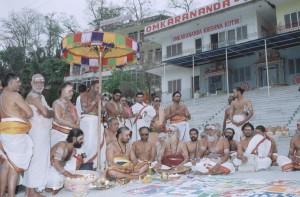|
Ashtabandhana
Mahakumbhabhishekam of
Omkarananda-Kamakshi-Devi Mandir
At Omkarananda
Ashram Himalayas, Rishikesh
From 1st to 4th April 2004
Thursday, 1st April 2004
The auspicious ceremony began early in the
morning at 5 o’clock with Nadaswaram by temple
musicians of Kancheepuram, specially invited for
this occasion. Along with this, the priests
started preparations for Hawanas and Pujas in
the newly built Yajnashala of the temple
complex. After performing an elaborate Sankalpa
at the Yajnashala, all the Sannyasis/disciples
of Gurudev and the priests led by Shri Kamakoti
Shastriji, proceeded to Gurudev’s room in the
nearby Omkarananda Shanta-Durga Mandir of the
Ashram to seek His Blessings and Permission for
the Mahakumbhabhishekam ceremony.

Priests
conducting Ganapati Hawan |
Thereafter, the Head
Priest Pandit Sureshji, son of Shri Kamakoti
Shastriji, conducted the main Hawana and Puja in
the Yajnashala. At first, Kalasha Puja, Deepa
Puja etc., and then Ganesha Puja was performed.
This was followed by Shodasha-Lakshmi-Avahana-Puja
with a big plate of coins and lotus flowers at
the centre. Alongside, Varuna Devata was invited
to consecrate the Kalasha water, with which then
the whole new temple area was purified. Another
big Kalasha was prepared with green leaves and
coconut and was taken by the priests and
Sannyasis to the Ganesha temple, in front of
Omkarananda Shanta-Durga Mandir, to transfer the
Prana of Lord Ganesha into this Kalasha to be
used for Kalasha-Sthapanam on the Omkara
Mahaganapati Mandir in the afternoon.
Ganapati Talam: On completion of the above
ceremony a beautiful and powerful Mantra of Lord
Ganesha was recited by a veteran South Indian
priest to invoke His Blessings for the Kalasha-Sthapanam.
This inspiring hymn for Lord Ganesha was set to
the ancient rhythm called ‘Ganapati Talam’.

Shodasha-Lakshmi-Avahana
Puja being performed by Shri Kamakoti
Shastriji (centre), Pandit Sureshji
(left) and Pandit Sudhakar Sharmaji
(right |
Ganapati Homa:
The morning ceremony continued with Agni-Prajvalanam,
i.e. lighting of the sacred fire. The Ashtaloka-Pala-Devata-Avahanam
was done, followed by Mantras to start the fire
and Shodashopachara-Ganapati-Puja, in which
Ahutis were offered. The main Hawan started in
an elaborate way with offerings like
Sahasra-Modaka (thousand special sweets), Ghee,
Gulab Jamun, rice powder, wheat, white rice,
fruit salad, puff-rice, white sesame etc. and
along with the recitation of Ganesha-Atharvashirsham,
which created a divine atmosphere around the
temple complex. The ceremony ended with powerful
recitation of selected portions from Rigveda,
Atharvaveda, Yajurveda and Samaveda by the team
of South Indian priests, and kept the devotees
and Sannyasis mesmerized for hours.
Navagraha-Homa: In
the afternoon, a Yajna for the Navagrahas (nine
planets), viz. Surya (Sun), Soma (Moon), Mangala
(Mars), Budha (Mercury), Brihaspati (Jupiter),
Shukra (Venus), Shani (Saturn), Rahu and Ketu,
was conducted by the assembled priests with the
recitation of appropriate Mantras. Purnahuti was
offered in Yajna, which was followed by Arati,
Mantrapushpam, Naivedyam etc. Consequently,
Kalasha-Sthapanam was conducted on the Omkara-Mahaganapati Mandir and Prasadam was distributed
to all.

Priest performing Ganapati and Ganga
Puja
at Omkarananda Public Ghat |
At 4.30 p.m., the priests went to the holy river
Ganga at Omkarananda Public Ghat, Muni-ki-reti.
They performed a ceremony to purify 16 big
Kalashas and 2 big-size umbrellas to be used for
Kumbhabhisheka. Kalashas were sanctified in a
fire lit with dried cow dung.
Ganapati Puja and Ganga Puja were performed at
the bank of holy Ganga, in which blessing and
permission was sought from Mother Ganga to allow
the use of holy water in performing Pujas for
the opening ceremony of the new temple. Then,
the priests took all the Kalashas, filled with
the holy water, on their heads, and Arati was
performed to them. Subsequently, the priests
proceeded towards the Ashram in a religious
procession led by temple musicians playing their
instruments in a befitting manner. On their
arrival at Omkarananda Shanta-Durga Mandir, they
were received with Karpoora-Arati on a plate
mixed with water and Kumkum. At that precise
moment, an unprecedented thing happened.
Suddenly, the priest holding the Kalasha meant
for Gurudev, went into a trance. Everybody present was pleasantly
surprised with this good omen, and surmised it
as a sign of Gurudev’s blessing finally
empowering the Kalasha.

Priests
seeking the blessings of Mother Ganga
for using Ganga Water for the
Kumbhabhisheka |

Priests carrying
holy Ganga Water from
the Ganga to Omkarananda-Kamakshi-Devi
Mandir |
In the evening, Vastu-Puja was performed beside
the Navagraha Temple and Kalasha-Sthapanam was
conducted. Hawan was conducted in Hawan-Kundas,
in which fire was lighted from the Karpura
Arati. A big figure, symbolising Vastupurusha,
was prepared out of dry grass, and it was
invoked with Mantras to purify the place and
free it from all evil forces. Hawan was
conducted to propitiate the Vastupurusha. A
priest prepared a Mandala on the ground with
white powder for the Chatuh-shashti-Yoginis, and
the 64 fields, representing each Yogini, were
worshipped with Mantras and offered a melon
anointed with Kumkum. This way, all the Bhutas
were satisfied with offerings. At the end, the
effigy of Vastupurusha was lighted and the smoky
Vashtupurusha was taken around the whole new
temple complex to drive away all the evil
forces. At this time, nobody was allowed to look
at the burning effigy. Further, some seeds were
planted into small vessels of clay near the
Pipal tree in the Ashram premises and these were
placed near the Chamundi Mandir after Puja.
Later, Prof. Shukla of Bhartiya Vidya Bhawan
delivered a short speech on this occasion and
exhorted the Sannyasis to recite Narayana-Sooktam
along with him. The last ritual of the day was
Rakshabandhanam conducted by Shri Kamakoti
Shastriji, in which a priest held a coconut in
his right hand while Shastriji fixed an
auspicious thread around his wrist. Shastriji
also tied sacred threads around the wrists of
other priests and silver bracelets on the wrists
of the Sannyasis. |
